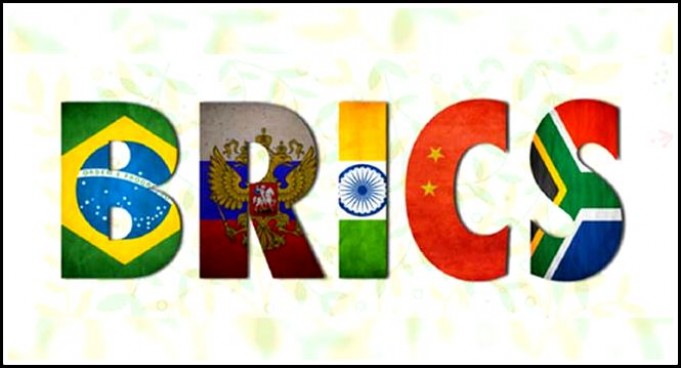The missing media discourse at BRICS
Image tweeted by BRICS 2016.
The 8th summit of BRICS with India as the Chair is under way in Goa. It is partially eclipsed in India by the media harangue with regard to the postponed SAARC summit. For the average citizen in each of the BRICS countries the summits may not mean much as a survey of their perceptions is not available or publicised if it exists. The media contexts have changed since many such regional and or economic blocs were formed to challenge or negotiate dominant economic orders. Our approaches and frameworks in positioning mainstream media (MSM) as bridges to enhance people to people understanding have also changed with ubiquitous faith in the “new” media.
Despite the fact that media constitutes an important mechanism of fostering and nurturing various aspects of relationships among and between these countries, the Goa summit and previous summits have not factored it in their sub group agenda or discussion forums. Within SAARC for example (perhaps too early to write its obit), media did form a part of deliberations. A BRICS media system study that coalesced around a project initiated by the University of Tampere in Finland assumes importance and may academically at least fill the void.
The comprehensive four-year project, in its final lap, through team members from respective countries focused on all aspects of media including social media, the set of media laws and regulations, and aspects of citizen journalism. Scholastic output by way of books published and forthcoming, journal articles and conference proceedings have come out of this multi-nation exercise. Such understanding may allow for both MSM and social media users to go beyond overshadowed and at times dominant bilateral agendas that in the long run threaten the purpose of such blocs.
Media system as a construct is academically attributed to the work of C. Hallin and Paolo Mancini and reviewers recognise that this work was intended to reflect the variations in media systems although confined to western democracies. As a unique effort, this BRICS project grappled with understanding the media and all its variants such as new media, and professional standards including journalism education.
It may be contentious to refer to BRICS as completely non-western in terms of their respective media. The legacies of Anglo Saxon liberal democratic traditions with regard to media practices is a dominant framework in India while the party-state differentiation or convergence with regard to media and market in China is another aspect. Yuezhi Zhao at Simon Fraser University states: “While the Party state continues to exercise tight control, and is gradually modernizing its controlling mechanisms, market forces have permeated and transformed every aspect of the media system. Through a series of overlapping processes of accommodation, appropriation, state-engineered market consolidation, and selective incorporation of private and foreign media capital, Party state power is increasingly converging with the power of capital in the Chinese media.”
Elena Vartanova from Moscow State University and a team member situates the Russian media system within what she describes as the Eurasian framework as different from the Anglo American. This recognises the strong state-market nexus with regard to media systems and the spectre of bribery, suppressed commercial motives of media enterprises and partisan connections of journalists to power elites. Raquel Paiva indicates that in Brazil a few families have a firm hold on the expressive part of the media to organise private communication networks with the Gobo network owned by the Marinho family as the dominant media entity. In a related reference, the impeachment of the former president is also attributed to the media. “Brazil has been plunged into a deepening political crisis, with its first female president suspended after five years in power. Dilma Rousseff’s supporters accuse the dominant media, owned by Brazil’s richest families, of fanning the flames of discord.” Herman Wasserman of Rhodes university argues that the South African is still reeling under “Apartheid ideology of exceptionalism” and situate itself more in the African context.
While such synoptic frameworks may not do enough justice to the actual spread and practices of media in these countries, they provide a nuanced perspective from scholars rooted in their contexts with a better view and understanding. The spread and use of social media is no doubt a common feature of the ecology. Resonance of corrupt practices by journalists and increasing economic clout of media enterprises and their accommodation of the agenda of the power elite was a common topic in the academic meetings. Community radio as in Brazil, India and South Africa was another media related discourse.
The team could not miss noticing the influence of the Chinese coordinated focus on communication education and their collaboration with leading journalism and mass communication schools in the US. It may be coincidental but significant to note that media reports in India did suggest that there was a proposal to establish a communication university on the lines of Chinese university. "There are many institutes that offer journalism and media courses here but it has been noted that there is a lack of clarity, depth and vision," the person said. "It is the PM's idea to have a university that churns out quality journalists and media professionals. In its 50th year of inception, the Indian Institute of Mass Communication is perhaps being viewed as a hub mechanism along with a clutch of journalism/patrikaritha universities as the spokes. It is time perhaps for other universities in India to think of focused efforts towards cadre training for the state and civil society.
Sanjay Bharthur teaches communication at the University of Hyderabad and was a member of the Prof Kaarle Nordenstreng led University of Tampere project on Media Systems in BRICS.







